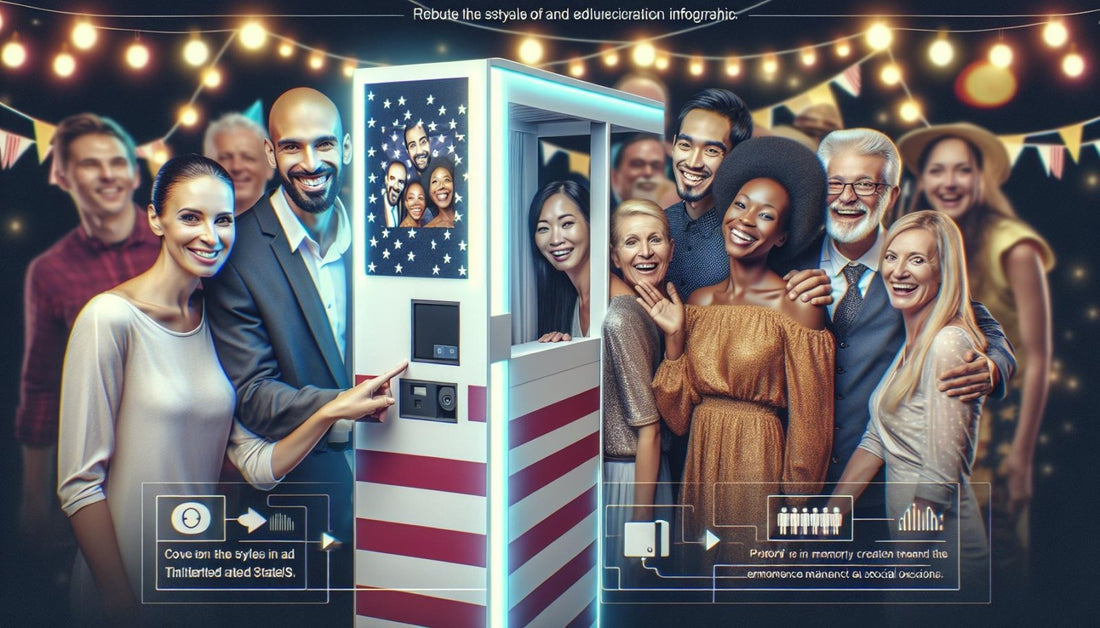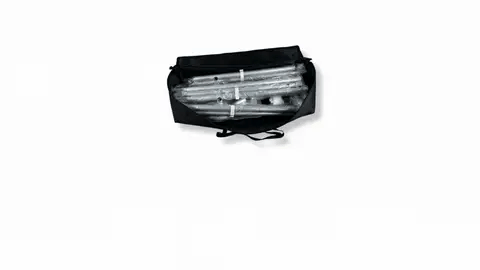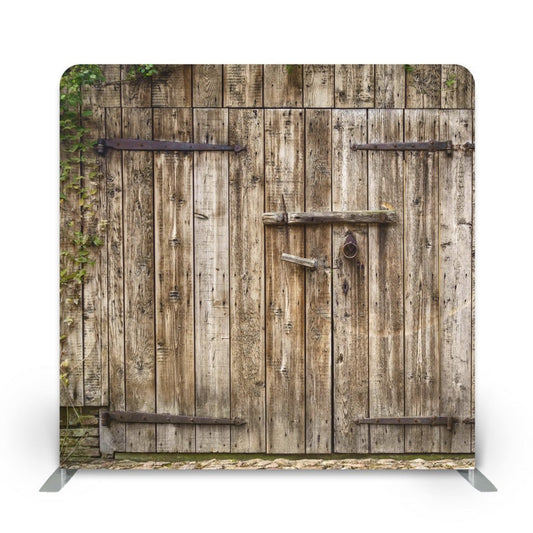
Top Photo Booth Biz Ideas for Success: Boost Profitability and Expand Your Services
Share
Starting a photo booth business can be a lucrative venture, whether you're aiming for a 1920s speakeasy vibe or a futuristic space station theme. With the right strategy, you could gross at least $12,000 per year by landing 40 events at $300 each. If you prefer fewer gigs, charging $600 per event for 20 events will meet the same goal. Prices can vary widely based on location, so what seems reasonable in a small town might be dirt cheap in a bustling metro area.
Beyond pricing, the success of your photo booth business hinges on factors like service quality, branding, and managing expenses. A strong brand can set you apart from competitors, making it easier to charge a premium. Additionally, don't forget the importance of insurance and permits. General Liability Insurance and Workers Compensation Insurance are essential to protect your business and employees, while proper licensing can save you from hefty fines or shutdowns.
Key Takeaways
- Lucrative Revenue Potential: A photo booth business can generate significant income, with flexible pricing strategies helping owners tailor their offerings to different market demands.
- Market Growth: The global photo booth market is expected to grow 12% annually, reaching $582.9 million by 2026, highlighting the increasing demand for these services.
- Affordable Start-Up Costs: Initial investment for a photo booth business ranges from $3,500 to $30,000, making it a viable option for many entrepreneurs.
- Diverse Booth Models: There are various types of photo booths available, including traditional enclosed, open-air, mirror, 360, and roamer booths, each catering to specific event needs.
- Essential Equipment: Quality cameras, lighting, backdrops, props, structures, and software are crucial for enhancing the photo booth experience and differentiating the business from competitors.
- Strategic Marketing and Operations: Building an online presence, networking, targeted advertising, excellent customer service, and effective booking systems are key to growing and sustaining a successful photo booth business.
Exploring Photo Booth Business Opportunities
Starting a photo booth business can be a profitable and enjoyable venture. For those ready to dive into this industry, understanding the revenue potential and market demand is crucial.
Why Start a Photo Booth Business?
The global photo booth market is expected to grow 12% annually, reaching $582.9 million by 2026. This growing demand presents a significant opportunity for new business owners. Compared to other ventures, photo booth businesses offer low start-up costs, ranging from $3,500 to $30,000 depending on the type of equipment and services offered. Entrepreneurs can also explore a plethora of franchise opportunities like TapSnap and Smybox, which cater to different event specialties.
Popular events (weddings, corporate events, and parties) require photo booths because they provide entertainment and instant photo-sharing on social media platforms like Instagram and Facebook. This feature benefits both users who enjoy the experience and hosts who gain immediate publicity. Additionally, setting up a photo booth with customizable "photo booth signs" and attractive "photo booth backdrops" can enhance the appeal and functionality of the service.
Evaluating the Market Demand
Market prices for photo booth rentals vary widely from one region to another. Rates of $300-$600 per event are reasonable in many small towns but might be considered cheap in metro areas. Pricing flexibility allows owners to tailor their packages according to their location and client requirements. For example, grossing $12,000 annually by operating 40 events per year at a minimum of $300 per event is feasible. The market demand also varies by region, impacting the number of events an owner can secure annually.
Over one entrepreneur reported $400,000 in gross revenue annually from a photo booth business, aiming to reach $500,000 by 2024. This revenue potential underscores the lucrative nature of this business, given the right strategy. Moreover, 75% of consumers admit to judging a company's credibility based on its website design, making an attractive, functional website crucial for booking clients and boosting brand recognition.
Incorporating these business ideas and focusing on market demand will position any photo booth business for success.
Types of Photo Booths and Equipment
Running a photo booth business requires knowledge of different models and essential equipment. Understanding these aspects can help optimize offerings and attract more clients.
Different Models of Photo Booths
- Traditional Enclosed Photo Booths: These classic booths offer a private space for guests to take photos. Popular at weddings and formal events, they provide an intimate setting.
- Open-Air Photo Booths: These models provide more space and versatility. Frequently used at large gatherings, open-air booths can accommodate groups and allow for creative backdrops. Investing in a stylish photo booth backdrop can enhance the setup and attract more clients.
- Mirror Photo Booths: These booths offer an interactive and elegant feature with a mirror-like surface. Perfect for upscale events, they combine function and aesthetics, making them a popular choice for corporate gatherings.
- 360 Photo Booths: Capable of capturing 360-degree photos and videos, these booths are used for technical and high-budget events. They deliver immersive experiences, making them a hit at tech-savvy venues.
- Roamer Photo Booths: Portable and flexible, these roaming booths can move around an event, capturing candid moments. Ideal for dynamic environments, such as festivals and large parties.
- DSLR Photo Booths: Leveraging high-quality DSLR cameras, these booths deliver superior photo quality. They are commonly used at luxury events where clients expect the best image resolution and clarity.
- High-Quality Camera: Investing in a top-notch camera is crucial for ensuring the best photo quality. DSLR cameras are recommended for their exceptional image resolution.
- Lighting: Proper lighting can make a significant difference in photo quality. Soft lights, such as ring lights, are popular for evenly lighting faces and avoiding harsh shadows.
- Backdrops: A creative photo booth backdrop adds a visual appeal and enhances photos. Different themes can cater to various event types.
- Props and Accessories: Adding fun props and accessories increases engagement. Unique items like hats, glasses, and signs can make the experience more enjoyable for guests. Check out various photo booth signs to add to the collection.
- Photo Booth Enclosure or Structure: Depending on the model, a sturdy and easily set up enclosure is essential. Make sure it can hold the equipment securely and is portable for ease of transportation.
- Software: Reliable photo booth software for capturing, editing, and printing photos is necessary. Software should be user-friendly and feature-rich.
Investing in quality equipment will not only enhance the photo booth experience but also set the business apart from competitors.
Setting Up Your Photo Booth Business
Starting a photo booth business involves several strategic steps to ensure success and profitability. Each step is vital in creating a well-rounded and efficient business model.
Business Planning and Budgeting
Conducting thorough market research identifies my target audience and their willingness to pay for photo booth services. Analyzing competitors helps me differentiate my business and discover unique selling propositions. Creating a detailed business plan outlines my objectives, target customers, marketing strategy, operational plan, and financial projections. This plan guides every business decision and keeps me focused on achieving my goals.
When budgeting, initial start-up costs range from $3,500 to $30,000 based on the type of equipment and services offered. It's crucial to account for additional costs such as insurance, marketing, and operational expenses. Choosing the right photo booth equipment, whether standalone booths, portable booths, or DIY kits, depends on my budget and business objectives. Ensuring the equipment is easy to use, reliable, and cost-effective is essential for providing a quality service to clients. I also recommend investing in photo booth signs and photo booth backdrops to enhance the customer experience.
Legal Considerations and Insurance
Registering my photo booth business as a legal entity protects my personal assets. I need to register for taxes, obtain the necessary permits and licenses, and set up a business bank account and credit card to keep all finances organized and separate from personal accounts. Setting up accounting ensures all financial records are accurate and up-to-date.
Securing business insurance is crucial to protect against unexpected liabilities and losses. This includes general liability insurance and specific coverage for my equipment and services. Legal compliance ensures long-term sustainability and protects my business from potential risks.
Ensuring my brand reflects my business values helps create a unique and memorable image. Establishing a business name, creating a logo, and developing a professional website fosters trust and attracts customers.
Each of these steps builds a solid foundation for a successful photo booth business.
Pricing and Revenue Models

Setting the right pricing and revenue model is vital for a successful photo booth business. I’ll explore competitive pricing strategies and additional revenue streams tailored to attract customers and boost profitability.
Setting Competitive Pricing
Understanding the competition is key to setting competitive pricing. In my market research, I found that photo booth rental rates vary significantly. The standard hourly rate ranges from $100 to $400 per hour. This means that offering a three-hour rental at around $700 can keep my services competitive yet profitable.
Many companies opt for a flat fee structure. In New York, the average price for a three-hour wedding photo booth rental stands at $1,300. This fee often includes basic services with extra costs for additional hours or premium features. I need to consider my cost structure and customer expectations to set a similar flat fee.
I also looked into package deals which bundle several add-ons such as customized props, photo guest albums, personalized photo strips, and social media sharing. Making these features available as package components can provide more value and justify a higher pricing point.
Exploring Additional Revenue Streams
Diversifying revenue streams can significantly enhance my photo booth business. Offering optional add-ons is a promising strategy. For instance, not every client may need customized props, but those who do might be willing to pay extra for them. It's essential to ensure these add-ons augment the overall experience and maintain consistency with my brand.
Add-ons like photo booth signs are popular and can enhance the booth setup. Customized signs, theme-based designs, or even interactive signs can boost the value offered to clients.
Another great add-on is the photo booth backdrop. Offering various backdrop options, such as 1920s speakeasy themes or futuristic space stations, can appeal to different client needs, potentially increasing the rates they’re willing to pay.
Conducting thorough market research helps identify what customers value. By understanding these aspects, I can create compelling offerings that drive additional revenue while enhancing client satisfaction.
Marketing Strategies for Photo Booth Business
Marketing a photo booth business involves multiple strategies to increase visibility and attract clients. From creating a robust online presence to networking, these techniques will help grow your business effectively.
Building an Online Presence
A professional website serves as your business's online face, showcasing services, a portfolio, and contact information. Optimizing the website for search engines enhances visibility and attracts more clients. Adding sections that highlight your unique offerings, like themed photo booths inspired by the 1920s speakeasy or futuristic spaces, can capture visitor interest. Include compelling visuals and detailed descriptions to make the content relatable.
Active engagement on social media platforms broadens your reach. Share your work, engage with potential clients, and build a community. Regular posts featuring event highlights or creative setups, including photo booth signs, can keep followers interested. Use hashtags and collaborate with influencers to amplify your reach.
For instance, if your website ranks on the first page of Google search results for "photo booth rental," and you service a large city, you could potentially book at least 40 events monthly. This strategy could generate annual gross sales around $383,520. However, you need three to four photo booths to service this demand.
Networking with Event Planners
Building partnerships with event planners, wedding venues, and other businesses in the event industry can provide a steady stream of clients. Collaborate on cross-promotion opportunities to reach new audiences. Offer joint packages with event planners or become the recommended photo booth provider for specific venues.
For instance, cross-promotions with wedding planners or corporate event organizers can include special deals that feature your photo booth prominently. Shared promotions on social media and websites further enhance visibility.
Additionally, networking can extend to offering tailored backdrops. For example, a customized photo booth backdrop for a themed corporate event can provide a unique selling point and foster future business relationships.
Targeted Advertising
Utilizing targeted advertising platforms like Facebook Ads and Google Ads helps you reach specific audiences. Craft compelling ad copies and visuals that highlight unique selling points. Ads should be directed toward demographics that typically book photo booths, like wedding planners, corporate event organizers, or party hosts.
Analyzing ad performance regularly ensures the optimization of your marketing budget. Adjust targeting based on the insights gained from ad analytics, and focus on high-performing keywords and demographics to maximize advertising effectiveness. Ensure your ads consistently redirect to your optimized website, offering complete, up-to-date information about your photo booth services.
Operational Strategies for Success

Implementing effective operational strategies can elevate a photo booth business. These strategies encompass customer service and booking systems.
Providing Excellent Customer Service
Delivering excellent customer service differentiates a photo booth business from competitors. Ensuring that the team is well-trained guarantees smooth operation, guest interaction, and quick issue resolution. Immediate responsiveness to customer inquiries showcases reliability and attentiveness. Tailoring each event to fit client needs, such as customized photo booth backdrops and themed props, enhances the personalized experience. Offering extra touches like complimentary prints and digital copies adds value, creating memorable moments for guests. For more unique customization ideas, consider exploring various photo booth signs.
Implementing Effective Booking Systems
Efficient booking systems streamline the reservation process, making it easier for clients to book services. An online booking platform that provides availability, pricing, and service descriptions can improve user experience and reduce administrative workload. Secure payment options and automated reminders ensure smooth transaction processes. An effective booking system should also track client preferences, event details, and special requests, ensuring the photo booth setup meets all specific requirements. Integrating customer feedback into the system can help improve service quality continually.
Including these strategies not only boosts operational efficiency but also enhances client satisfaction and retention.
Scaling and Expanding Your Business
Scaling and expanding a photo booth business requires strategic planning and implementation. Growth hinges on understanding market needs and offering diverse, compelling services.
Strategies for Growth
Conducting market research is essential. Identify new opportunities, target specific demographics, and analyze competitors. This helps tailor services to meet client demands. Regularly review market trends and adjust offerings accordingly.
Networking with event planners can significantly boost bookings. Building relationships with planners helps secure high-demand events. Offering unique packages and deals tailored for different occasions, such as weddings or corporate functions, can set you apart. Use themed photo booth signs and photo booth backdrops to enhance your packages.
Collecting customer feedback provides valuable insights for improvement. Implement online surveys, monitor social media, and use feedback cards to gather customer opinions. Incentivize responses with discounts or special offers to increase participation. Follow-up emails post-event can also encourage feedback.
Diversifying Your Offerings
Expanding services keeps the business competitive. Introduce various photo booth options like themed booths, green screen technology, slow-motion video booths, and GIF booths. Each option caters to different events, attracting a broader audience.
Invest in the latest technology to enhance user experience. Compact and interactive displays make the experience more engaging. Keep equipment updated to offer the best service possible. Incorporate advanced features like instant photo printing and personalized props to elevate customer experience.
Utilize social media effectively to showcase new offerings. Post examples of unique setups and features to attract clients. Use targeted ads to reach potential customers interested in photo booths for their events.
Diversifying doesn’t just stop at the services offered; consider different pricing tiers. Offer basic, premium, and VIP packages. Each tier provides varying levels of service, ensuring you cater to different budgets.
By implementing these strategies, scaling and expanding a photo booth business becomes feasible and profitable, helping meet and exceed client expectations.
Conclusion
Running a photo booth business offers numerous opportunities for creativity and profitability. By focusing on high-quality equipment, strong branding, and effective marketing strategies, I've found that it's possible to create a memorable experience for clients. Offering diverse services and staying updated with the latest technology can significantly boost growth. Networking with event planners and using social media effectively are crucial for expanding the business. With strategic planning and a commitment to excellent service, the photo booth business can thrive and meet the evolving needs of clients.
Frequently Asked Questions
How profitable is running a photo booth business?
Running a photo booth business can be highly profitable with proper pricing strategies, excellent service quality, and effective expense management. Profitability depends on factors like location, event frequency, and operating expenses.
What are some effective marketing strategies for a photo booth business?
Effective marketing strategies include building an online presence, engaging on social media, networking with event planners, and utilizing targeted advertising platforms. These tactics help increase brand awareness and attract potential clients.
What's the best type of photo booth for events?
Open-air photo booths are a top choice for event planners due to their versatility, accessibility, and shareability. They offer an interactive experience and visually appealing designs that enhance events.
How can I attract more customers to my photo booth business?
To attract more customers, build a strong online presence, leverage social media, network with event planners, offer competitive pricing, and run targeted advertising campaigns. Providing excellent customer service also aids in word-of-mouth referrals.
How can I grow my photo booth business?
To grow your photo booth business, focus on market research, networking, offering unique packages, collecting customer feedback, and diversifying services with new photo booth options and technology. Implementing different pricing tiers and effectively utilizing social media are also crucial.
What are some essential operational strategies for a photo booth business?
Essential operational strategies include providing excellent customer service, implementing efficient booking systems, and ensuring customer satisfaction and retention. These practices help in building a loyal customer base and streamlining operations.
How important is branding for a photo booth business?
Branding is crucial as it sets your business apart from competitors and creates a strong identity. A well-defined brand helps in attracting clients, establishing trust, and conveying professionalism and reliability.
Can offering diverse services enhance the profitability of a photo booth business?
Yes, offering diverse services such as various photo booth options, unique packages, and advanced technological features can meet different client needs and increase profitability. Diversification helps in attracting a broader audience and tapping into new market segments.






